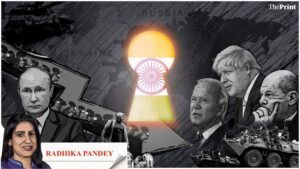JUNE 2, 2022

India’s gross domestic product (GDP) grew at a slower pace at 4.1 per cent in the January-March quarter. The slowdown in growth reflected the impact of the Omicron wave-induced restrictions and disruptions due to the Russia-Ukraine war.
The spike in inflation due to the war is seen to have dampened consumption in the March quarter. Going forward, while the impact of the Covid-induced disruptions on growth is likely to dissipate, challenges remain on account of the Russia-Ukraine war, high commodity prices, pace of monetary policy tightening by central banks, and a slowdown in global growth weighing on India’s exports.
Hits and misses in the quarterly numbers
While agricultural growth remained robust, the manufacturing sector contracted due to high input cost pressures and supply side bottlenecks in the March quarter. The labour-intensive construction sector posted a positive growth after a contraction in the previous quarter due to the government’s capex push and a revival in the real estate sector.
From the expenditure side, the key cause of concern has been the moderation in consumption. The share of consumption in GDP declined from 63 per cent in the December quarter to 59 per cent in the March quarter. However, the share of investment in GDP showed an encouraging rise.
Recovery in 2021-22
Apart from the quarterly growth estimates, the National Statistics Office (NSO) released the annual growth numbers for 2021-22 (FY 2022). With an 8.7 per cent growth in 2021-22, India continues to remain the fastest growing economy in 2021-22 despite a slowdown in the March quarter.
The annual growth numbers are significant as they reveal the pace of recovery after the economy was hit by the Covid-19 pandemic in 2020. Most sectors apart from the contact-intensive sectors (trade, hotels, transport, communication and services) have attained their pre-pandemic levels. The contact-intensive services are still 89 per cent of their pre-pandemic levels.
The annual numbers also show that consumption posted a muted growth in 2021-22. Its share in GDP has seen a decline as elevated inflation and waves of pandemic took a toll on discretionary spending. The silver lining has been the performance of investment. Its share in GDP has seen an increase.
Risk of global stagflation
The record high global inflation and aggressive tightening by central banks amid an uneven growth recovery has sparked fears of stagflation. Stagflation becomes a concern when inflation is high in a period of slow economic growth. Owing to the economic damage from the Russia-Ukraine conflict, the International Monetary Fund (IMF) in its April World Economic Outlook has sharply cut its projection for global growth from 6.1 per cent in 2021 to 3.6 per cent in 2022. Due to the war-induced price pressures, the IMF has raised inflation projections for both advanced and emerging economies.
Central banks world over are facing the challenge of achieving a soft landing, that is taming inflation without triggering a sharp economic downturn. In the US, there are concerns that the quick pace of tightening by the Federal Reserve could create recessionary conditions.
The US targets long-term inflation of 2 per cent, but inflation has skyrocketed to more than 8 per cent in recent months. The probability of recession in Europe has also increased as it has been much harder hit by the economic impact of the Ukraine war amid record spike in inflation.
Stagflation risk in India is currently low
Even as elevated inflation poses a challenge to growth, many high frequency indicators suggest that growth has remained resilient. The Manufacturing Purchasing Managers’ Index (PMI) stood at 54.6 in May, from 54.7 in April, pointing to a sustained recovery across the sector.
The PMI also suggests improvement in manufacturing sector jobs due to improvement in sales. Goods and Services Tax (GST) collections for the month of May came in at over Rs 1.4 lakh crore. Though 15 per cent lower than the last month, the collections are still robust and indicate improved economic activity.
The forecast of above normal monsoon will have a positive impact on retail inflation. Double-digit growth in credit seen in the recent data implies a pick up in investment activity. Credit to large industries is also showing signs of a pick-up. The revival in investment and construction needs to be sustained in the coming months. Consumer sentiments and employment still need to see a sustained turnaround.
The fiscal policy measures announced by the government will help in moderating inflation. However, there are near-term risks to inflation. The fresh set of sanctions by the European Union (EU) on Russian oil will lead to an increase in crude prices. There could be a possible impact of heatwave on vegetable prices in the coming months. The RBI has indicated that it will hike the policy rate in forthcoming June and August meeting.
If war-related disruptions do not subside in the near-term and elevated inflation persists for long, there could be a potential risk of slowdown in growth. Managing growth, inflation, fiscal and current account deficit will be a continuing policy challenge for the government and the RBI.
Radhika Pandey is a consultant at National Institute of Public Finance and Policy.
Views are personal.










































































































